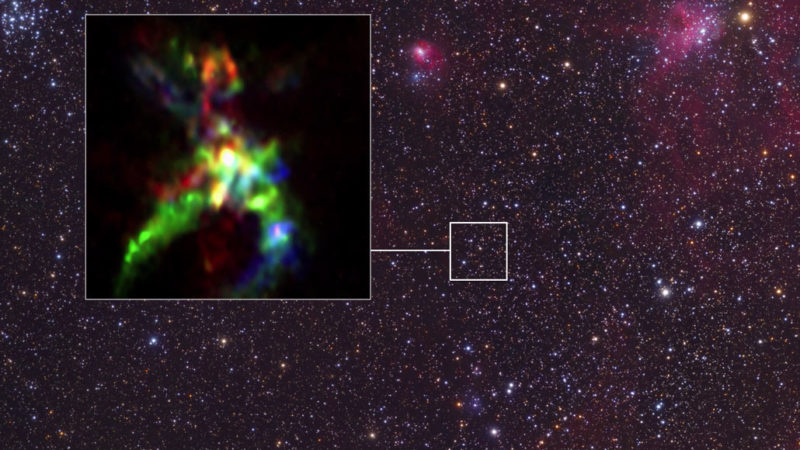

Jets of energy erupting from a young newborn star (inset), within a star-forming cloud of gas and dust. Those jets are creating molecules of phosphorus – an element necessary for life as we know it – within the cloud. Image via ALMA/ ESO/ NAOJ/ NRAO/ V.M. Rivilla et al/ Mario Weigand/ www.skytrip.de/ Science News.
When you think of life elsewhere in the universe, you might think first of SETI – the Search for Extraterrestrial Intelligence – which focuses primarily on evidence for alien civilizations. But what about simpler forms of life, such as microbes or vegetation on a far-away exoplanets? To find signs of such simple lifeforms with our existing technologies, researchers have focused on analyzing the atmospheres of distant worlds for possible biosignatures, such as oxygen, methane or carbon dioxide. Now, it seems, there’s another element – phosphorus – that might also have a major role to play in the search for life elsewhere.
Phosphorus is one of the primary ingredients needed for life on Earth.
Researchers at the Southwest Research Institute (SwRI) announced earlier this month that they have been exploring a new way to narrow down which planets might be the most suitable for life. Their method is based on how much phosphorus the planets’ host stars contain.
The new peer-reviewed paper was published September 11, 2020, in The Astrophysical Journal Letters.

A Southwest Research Institute scientist has identified stellar phosphorus as a probable marker in narrowing the search for life on exoplanets. Stars with phosphorus levels similar to the sun are considered more likely to host rocky planets with the potential to host life as we know it. Image via NASA/ JPL-Caltech/ SwRI.
Natalie Hinkel, a planetary astrophysicist and lead author of the new study, said in a statement:
When searching for exoplanets and trying to see whether they are habitable, it’s important that a planet be alive with active cycles, volcanoes and plate tectonics. My coauthor, Dr. Hilairy Hartnett, is an oceanographer and pointed out that phosphorus is vital for all life on Earth. It is essential for the creation of DNA, cell membranes, bones and teeth in people and animals, and even the sea’s microbiome of plankton.
Hinkel has developed techniques to help find out which stars have exoplanets (which is by far most of them), and says that upcoming studies should focus on looking for phosphorus specifically.
Even though scientists can’t yet determine the specific elemental ratios for individual exoplanets, they can study the host stars for clues, since planets tend to have compositions similar to their stars. If a star contains a significant amount of phosphorus, for example, then it is likely that the star’s planets do as well. This is important, since phosphorus is needed for all known life on Earth, along with five other key elements: carbon, hydrogen, nitrogen, oxygen and sulfur.
Phosphorus can be found in Earth’s oceans, but it is the least available of all those elements, and so is considered to be the “ultimate limiting nutrient for life.” For all of the diverse life on this planet, Earth actually has a rather low abundance of phosphorus, another puzzle that scientists are trying to solve. Most of Earth’s phosphorus is locked up in minerals in the crust.

Phosphorus is one of the six main chemical elements needed for the building blocks of life as we know it. Image via Roanoke Landscapes.

Mono Lake in Eastern California. This salty lake – with salt pillars – is rich in carbonates and phosphorus, similar to lakes that scientists think helped with the evolution of life on Earth billions of years ago. Image via Matthew Dillon/ Flickr/ University of Washington.
Hinkel decided to use the phosphorus abundance ratios in marine plankton and the Earth’s crust, as well as the bulk silicate mineral amounts of Earth and Mars as a base to compare with the carbon, nitrogen, silicon and phosphorus abundance ratios of nearby stars. She used the Hypatia Catalog, a publicly available stellar database that she had also developed. You can search through the database yourself to explore stellar abundance data for 9,434 stars. This kind of database is crucial, since little is known still about how abundant phosphorus is in different stars. Hinkel said:
But there’s so little phosphorus stellar abundance data. Phosphorus data exists for only about 1% of stars. That makes it really difficult to figure out any clear trends in between the stars, let alone the role of phosphorus in the evolution of an exoplanet.
Scientists don’t yet know how abundant phosphorus is among different stars, due to it being difficult to detect. In the light spectrum, it sits at the edge of the optical, or visual, wavelengths of light and infrared light, a region that typically isn’t observed a whole lot. It may be that phosphorus is very common in stars, but scientists are lacking the data to know for sure. As Hinkel noted:
Our sun has relatively high phosphorus and Earth biology requires a small, but noticeable, amount of phosphorus. So, on rocky planets that form around host stars with less phosphorus, it’s likely that phosphorus will be unavailable for potential life on that planet’s surface. Therefore, we urge the stellar abundance community to make phosphorus observations a priority in future studies and telescope designs.

Natalie Hinkel at SwRI, lead author of the new study. Here she is giving a plenary talk at the Cool Stars 18 conference in Flagstaff, Arizona, in 2014. Image via Natalie Hinkel.
So in the matter of finding life that is similar to life on Earth in terms of its building blocks, the more phosphorus that’s out there the better. Of course, there may well also be life out there that is truly alien to anything we know of on our planet, but for the moment, the template of earthly life is what we have to go on. Phosphorus has also been found in the gas and dust clouds of newborn stars as well as comets.
Earlier this year, another study from researchers at the University of Washington suggested that carbonate and phosphorus-rich lakes helped to kick-start life on Earth. That would help explain how life started here, even though phosphorus is relatively scarce on Earth overall. These lakes – called soda lakes – can contain up to 50,000 times more phosphorus than seawater, rivers and other types of lakes. This would seem to make them ideal locations for life to originate and evolve. These lakes are known to host a wide variety of life, from microbes to flamingoes.
Phosphorus is essential for all life on Earth. Now by finding out how much phosphorus other stars and planets contain, researchers can begin to identify how many of those planets could support life (at least life as we know it). That is a promising and exciting development in the search for other inhabited worlds.
Bottom line: Scientists develop a new way to search for potentially habitable exoplanets by looking for phosphorus in their stars.
Source: The Influence of Stellar Phosphorus on Our Understanding of Exoplanets and Astrobiology
Via Southwest Research Institute
from EarthSky https://ift.tt/3ileoio


Jets of energy erupting from a young newborn star (inset), within a star-forming cloud of gas and dust. Those jets are creating molecules of phosphorus – an element necessary for life as we know it – within the cloud. Image via ALMA/ ESO/ NAOJ/ NRAO/ V.M. Rivilla et al/ Mario Weigand/ www.skytrip.de/ Science News.
When you think of life elsewhere in the universe, you might think first of SETI – the Search for Extraterrestrial Intelligence – which focuses primarily on evidence for alien civilizations. But what about simpler forms of life, such as microbes or vegetation on a far-away exoplanets? To find signs of such simple lifeforms with our existing technologies, researchers have focused on analyzing the atmospheres of distant worlds for possible biosignatures, such as oxygen, methane or carbon dioxide. Now, it seems, there’s another element – phosphorus – that might also have a major role to play in the search for life elsewhere.
Phosphorus is one of the primary ingredients needed for life on Earth.
Researchers at the Southwest Research Institute (SwRI) announced earlier this month that they have been exploring a new way to narrow down which planets might be the most suitable for life. Their method is based on how much phosphorus the planets’ host stars contain.
The new peer-reviewed paper was published September 11, 2020, in The Astrophysical Journal Letters.

A Southwest Research Institute scientist has identified stellar phosphorus as a probable marker in narrowing the search for life on exoplanets. Stars with phosphorus levels similar to the sun are considered more likely to host rocky planets with the potential to host life as we know it. Image via NASA/ JPL-Caltech/ SwRI.
Natalie Hinkel, a planetary astrophysicist and lead author of the new study, said in a statement:
When searching for exoplanets and trying to see whether they are habitable, it’s important that a planet be alive with active cycles, volcanoes and plate tectonics. My coauthor, Dr. Hilairy Hartnett, is an oceanographer and pointed out that phosphorus is vital for all life on Earth. It is essential for the creation of DNA, cell membranes, bones and teeth in people and animals, and even the sea’s microbiome of plankton.
Hinkel has developed techniques to help find out which stars have exoplanets (which is by far most of them), and says that upcoming studies should focus on looking for phosphorus specifically.
Even though scientists can’t yet determine the specific elemental ratios for individual exoplanets, they can study the host stars for clues, since planets tend to have compositions similar to their stars. If a star contains a significant amount of phosphorus, for example, then it is likely that the star’s planets do as well. This is important, since phosphorus is needed for all known life on Earth, along with five other key elements: carbon, hydrogen, nitrogen, oxygen and sulfur.
Phosphorus can be found in Earth’s oceans, but it is the least available of all those elements, and so is considered to be the “ultimate limiting nutrient for life.” For all of the diverse life on this planet, Earth actually has a rather low abundance of phosphorus, another puzzle that scientists are trying to solve. Most of Earth’s phosphorus is locked up in minerals in the crust.

Phosphorus is one of the six main chemical elements needed for the building blocks of life as we know it. Image via Roanoke Landscapes.

Mono Lake in Eastern California. This salty lake – with salt pillars – is rich in carbonates and phosphorus, similar to lakes that scientists think helped with the evolution of life on Earth billions of years ago. Image via Matthew Dillon/ Flickr/ University of Washington.
Hinkel decided to use the phosphorus abundance ratios in marine plankton and the Earth’s crust, as well as the bulk silicate mineral amounts of Earth and Mars as a base to compare with the carbon, nitrogen, silicon and phosphorus abundance ratios of nearby stars. She used the Hypatia Catalog, a publicly available stellar database that she had also developed. You can search through the database yourself to explore stellar abundance data for 9,434 stars. This kind of database is crucial, since little is known still about how abundant phosphorus is in different stars. Hinkel said:
But there’s so little phosphorus stellar abundance data. Phosphorus data exists for only about 1% of stars. That makes it really difficult to figure out any clear trends in between the stars, let alone the role of phosphorus in the evolution of an exoplanet.
Scientists don’t yet know how abundant phosphorus is among different stars, due to it being difficult to detect. In the light spectrum, it sits at the edge of the optical, or visual, wavelengths of light and infrared light, a region that typically isn’t observed a whole lot. It may be that phosphorus is very common in stars, but scientists are lacking the data to know for sure. As Hinkel noted:
Our sun has relatively high phosphorus and Earth biology requires a small, but noticeable, amount of phosphorus. So, on rocky planets that form around host stars with less phosphorus, it’s likely that phosphorus will be unavailable for potential life on that planet’s surface. Therefore, we urge the stellar abundance community to make phosphorus observations a priority in future studies and telescope designs.

Natalie Hinkel at SwRI, lead author of the new study. Here she is giving a plenary talk at the Cool Stars 18 conference in Flagstaff, Arizona, in 2014. Image via Natalie Hinkel.
So in the matter of finding life that is similar to life on Earth in terms of its building blocks, the more phosphorus that’s out there the better. Of course, there may well also be life out there that is truly alien to anything we know of on our planet, but for the moment, the template of earthly life is what we have to go on. Phosphorus has also been found in the gas and dust clouds of newborn stars as well as comets.
Earlier this year, another study from researchers at the University of Washington suggested that carbonate and phosphorus-rich lakes helped to kick-start life on Earth. That would help explain how life started here, even though phosphorus is relatively scarce on Earth overall. These lakes – called soda lakes – can contain up to 50,000 times more phosphorus than seawater, rivers and other types of lakes. This would seem to make them ideal locations for life to originate and evolve. These lakes are known to host a wide variety of life, from microbes to flamingoes.
Phosphorus is essential for all life on Earth. Now by finding out how much phosphorus other stars and planets contain, researchers can begin to identify how many of those planets could support life (at least life as we know it). That is a promising and exciting development in the search for other inhabited worlds.
Bottom line: Scientists develop a new way to search for potentially habitable exoplanets by looking for phosphorus in their stars.
Source: The Influence of Stellar Phosphorus on Our Understanding of Exoplanets and Astrobiology
Via Southwest Research Institute
from EarthSky https://ift.tt/3ileoio

Aucun commentaire:
Enregistrer un commentaire